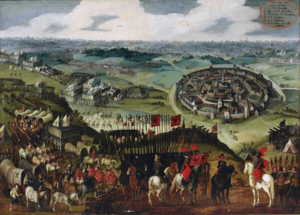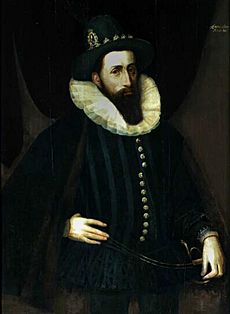War of the Jülich Succession facts for kids
Quick facts for kids War of the Jülich Succession |
|||||||
|---|---|---|---|---|---|---|---|
| Part of European wars of religion and the Eighty Years' War |
|||||||
 The Siege of Aachen by the Spanish Army of Flanders under Ambrogio Spinola in 1614. Oil on canvas. Attributed to Peter Snayers. |
|||||||
|
|||||||
| Belligerents | |||||||
| 1609–1610: |
1609–1610: Protestant Union |
||||||
| 1614: |
1614: |
||||||
| Commanders and leaders | |||||||
| 1609–1610: 1614: |
1609–1610: Otto von Solms–Braunfels 1614: |
||||||
The War of the Jülich Succession was a conflict over who would rule the United Duchies of Jülich-Cleves-Berg. These duchies were important lands in Europe. The war happened in two main parts. The first part was from June 10, 1609, to October 24, 1610. The second part started in May 1614 and ended on October 13, 1614.
In the first part, Archduke Leopold V, who was Catholic, fought against Protestant forces. These forces were from the Margraviate of Brandenburg and Palatinate-Neuburg. Leopold V was defeated. Later, the leaders of Brandenburg and Neuburg started fighting each other. This happened because they changed their religions. One became a Calvinist and the other a Catholic.
The war became even more complicated when Spain and the Netherlands got involved. This made it part of the larger Eighty Years' War. It was also part of the European wars of religion that were happening across Europe. The war finally ended with the Treaty of Xanten. This treaty gave more advantages to Spain.
Contents
Why the War Started
After the Protestant Reformation, new Christian beliefs like Lutheranism and Calvinism spread quickly. The Roman Catholic Church responded with its own movement, called the Counter-Reformation. These religious differences often led to conflicts. Examples include the Cologne War and the Strasbourg Bishops' War.
To protect their interests, Catholic nobles formed the Catholic League. Protestant nobles formed the Protestant Union. These groups first clashed in 1609. This was when a problem arose over who would inherit the United Duchies of Jülich-Cleves-Berg.
These duchies covered a large area of about 14,000 square kilometers. They were important because they were close to the Spanish Road. This was a key route for Spanish armies. The region also had a strong economy. Many refugees from the Eighty Years' War moved there, helping its growth.
Johann Wilhelm, Duke of Jülich-Cleves-Berg, who was very ill, died on March 25, 1609. He had no children to take over. The Holy Roman Emperor, Rudolf II, claimed the duchies because of family marriages. But he couldn't openly say so, as he was supposed to be neutral.
Six other people also claimed the duchies. Only the rulers of Margraviate of Brandenburg and Duchy of Palatinate-Neuburg had strong claims. Their claims came from their marriages to Johann Wilhelm's aunts.
On April 2, a temporary government was set up. It included the duke's wife and other officials. On May 24, Emperor Rudolf II announced that a court would decide the matter within four weeks.
The Conflict Begins
Brandenburg and Neuburg saw the temporary government as an attempt to take over the duchies. So, on June 10, 1609, they signed the Treaty of Dortmund. In this agreement, they rejected all other claims. They also formed their own temporary government with local leaders. Their armies then entered the duchies, ignoring the existing government and the Emperor.
In January 1610, Henry IV of France made a military agreement with the Protestant Union. He sent 22,000 soldiers to northeastern France. The Dutch also sent many troops towards Schenkenschanz. This was a show of strength against Spain.
Archduke Leopold V wanted to gain power. He convinced the Emperor to cancel the Treaty of Dortmund. Leopold was then appointed as the Emperor's representative. Leopold entered Jülich in triumph. But soon, he was surrounded by an army three times larger than his. Fighting also spread to Aachen and Düren.
The fight between the Catholic royal family and the Protestant princes caused fear. People worried about a larger religious war. The Protestant Union gathered 5,000 soldiers. Leopold recruited 1,000 cavalry and 3,000 foot soldiers in the Prince-Bishopric of Strasbourg. His family, the Habsburgs, and the Catholic League did not openly support Leopold. They only gathered troops for their own protection.
On March 13, 1610, Protestant Count Otto von Solms–Braunfels invaded Strasbourg with 2,000 soldiers. The Catholics simply went into walled towns like Saverne. They waited until the invaders ran out of money and left. A meeting was planned in Prague on May 1, 1610, to find a solution. Rudolf's first idea was to give the whole duchy to Christian II, Elector of Saxony. But many moderate princes disagreed. This led to delays in talks until August.
A second Protestant invasion happened. This time, 9,800 soldiers and cannons were involved. They managed to capture Dachstein, Mutzig, and Molsheim. But this attack also stopped when local people refused to give them food. Meanwhile, Leopold had left Jülich, leaving 1,500 soldiers inside.
Their fate was sealed when the Kingdom of France and the Dutch Republic finally joined the Protestants. They wanted to challenge Spain by putting pressure on the Spanish Road. The Dutch stopped a group of soldiers coming from the Prince-Bishopric of Liège. They also boosted the attacking forces to 25,200 soldiers. On September 1, the soldiers inside Jülich surrendered. They were allowed to leave safely.
On October 24, the Protestant Union and the Catholic League agreed to pull back their forces. They also agreed to disband them by the end of the year. The war cost a lot of money for everyone involved. This led to higher taxes. The leaders of Brandenburg and Neuburg, Wolfgang Wilhelm von Pfalz-Neuburg and Joachim Ernst, Margrave of Brandenburg-Ansbach, took over the duchy by force. But they did not get official recognition.
Second Phase of the War
In 1611, Protestantism spread to the towns of Stolberg and Weiden, near Aachen. In response, the city council of Aachen fined people who went to Protestant church services. Five citizens were arrested for ignoring this rule and refusing to pay. This led to a riot against the council on July 5.
The Catholic council members were forced out. Many Catholic buildings were damaged. A new Protestant council was formed. They asked for help from the leaders of Brandenburg and Neuburg. In 1612, Emperor Rudolf ordered the city of Aachen to bring back Catholic rule. He threatened to punish the city if they didn't. However, the Protestants in Aachen ignored the order. They even hurt an official sent by the Emperor to make sure the order was followed.
After Rudolf died, Emperor Matthias confirmed Saxony's right to the duchy. This reignited the dispute. Also, the leaders of Brandenburg and Neuburg changed their religions. One became a Calvinist and the other a Catholic. This completely changed their old alliances. By early 1614, officials from Brandenburg and Neuburg stopped talking to each other.
In May 1614, 300 Dutch soldiers removed the Neuburg army from Jülich. This was an attempt by Dutch leader Johan van Oldenbarnevelt to stop Brandenburg from plotting against Neuburg. Wolfgang Wilhelm saw this as a declaration of war. He raised 900 soldiers and captured Düsseldorf. The new Brandenburg leader, George William, was indeed planning a takeover. But he depended on Dutch money, so he couldn't carry out his plans.
Another misunderstanding happened. Spain and Albert VII, Archduke of Austria thought the Dutch military buildup broke a peace agreement called the Twelve Years' Truce. So, they gathered 13,300 foot soldiers and 1,300 cavalry. These forces were led by Spanish General Ambrogio Spinola.
On February 20, 1614, Emperor Matthias ordered Aachen to restore Catholic rule. Fearing an attack, the city council asked for help from Brandenburg. Brandenburg sent soldiers under General Georg von Pulitz to help the local army. On August 24, Spinola besieged Aachen. He claimed he was enforcing an old imperial order from Rudolf. After several days of talks, the soldiers in Aachen were allowed to leave. Protestant religious leaders and non-citizens also left. The old city council was put back in power. Those who took part in the 1611 riots were punished. From Aachen, Spinola moved on to capture Düren, Neuss, Wesel, and Mülheim. He did this with Wolfgang Wilhelm's help. The Dutch occupied the duchy of Mark and the rest of Cleves. They also strengthened their forces in Jülich.
Aftermath of the War
On October 13, 1614, Spinola and Maurice of Nassau began peace talks. France and England helped mediate these talks. The conflict ended with the signing of the Treaty of Xanten on November 12.
The areas of Jülich-Berg and Ravenstein went to Wolfgang Wilhelm of Neuburg. The areas of Cleves-Mark and Ravensberg went to George William. Spain gained control of 62 towns. This included three important crossings of the Rhine River: Wesel, Orsoy, and Rheinberg. This greatly improved Spain's position in northwestern Europe.
The Dutch kept their soldiers in Jülich and Pfaffenmütze. However, they were now surrounded or cut off. This put them in a difficult spot when the Twelve Years' Truce ended in April 1621.
See also
 In Spanish: Crisis de la sucesión de Juliers-Cléveris para niños
In Spanish: Crisis de la sucesión de Juliers-Cléveris para niños


